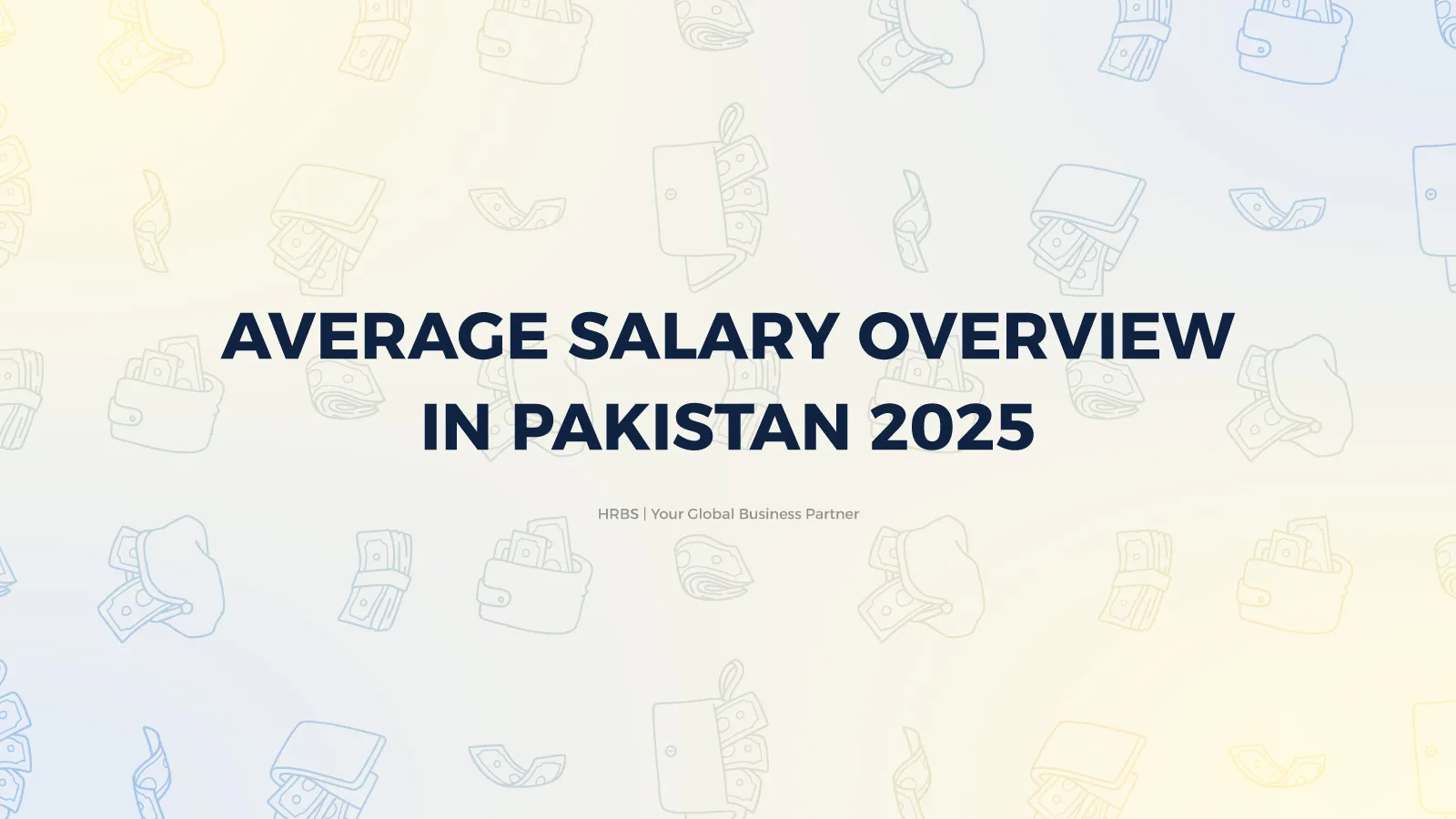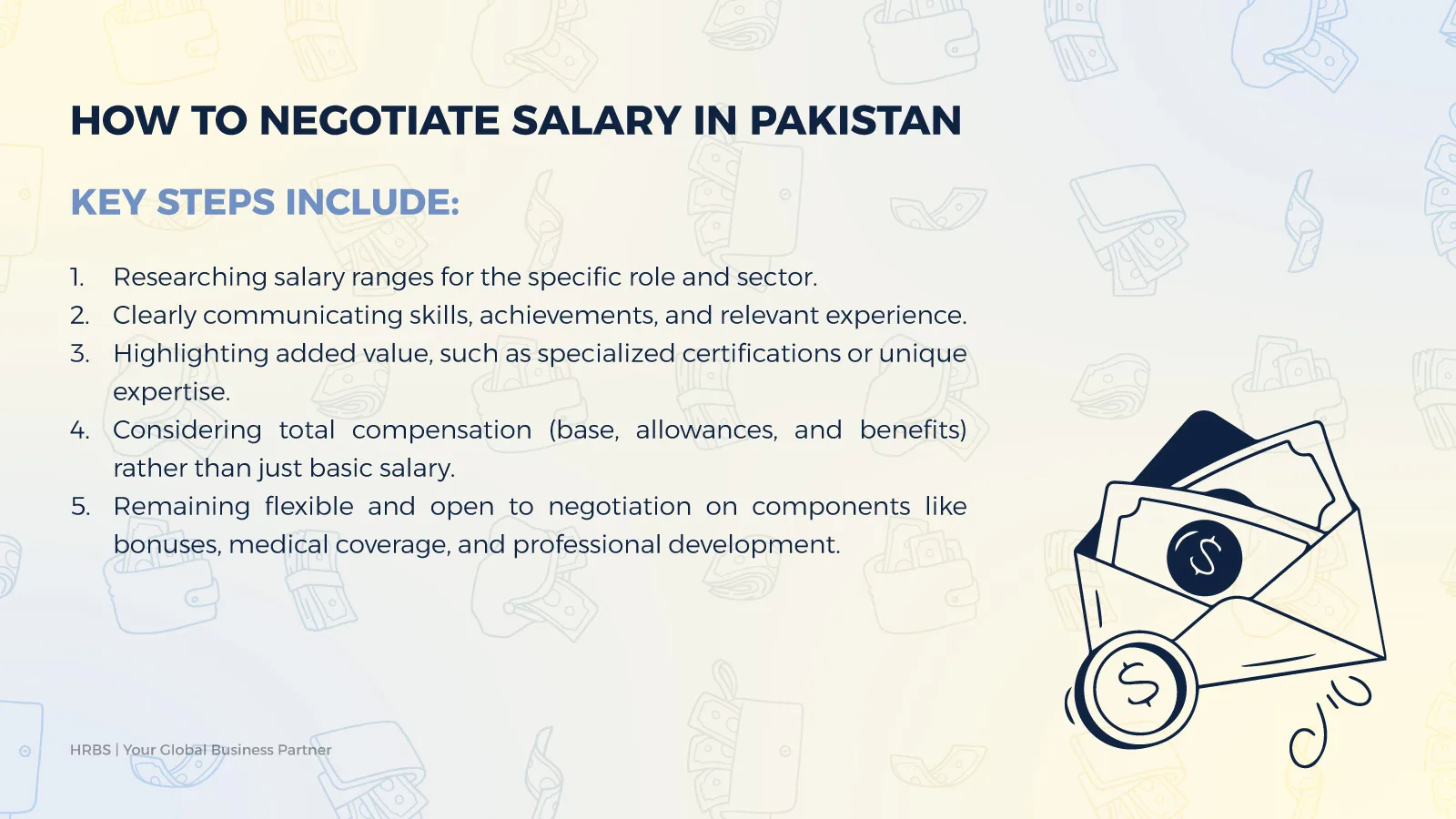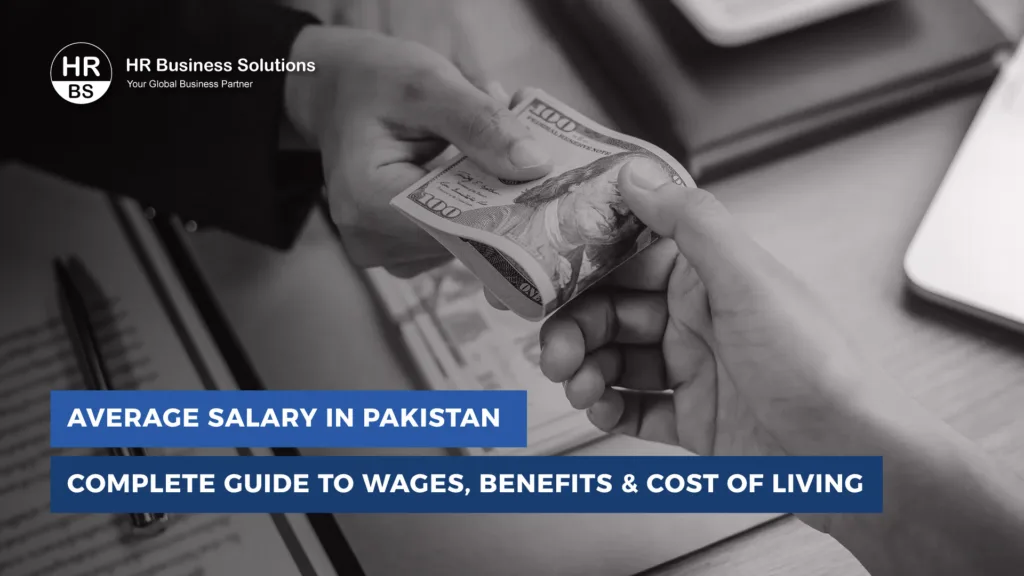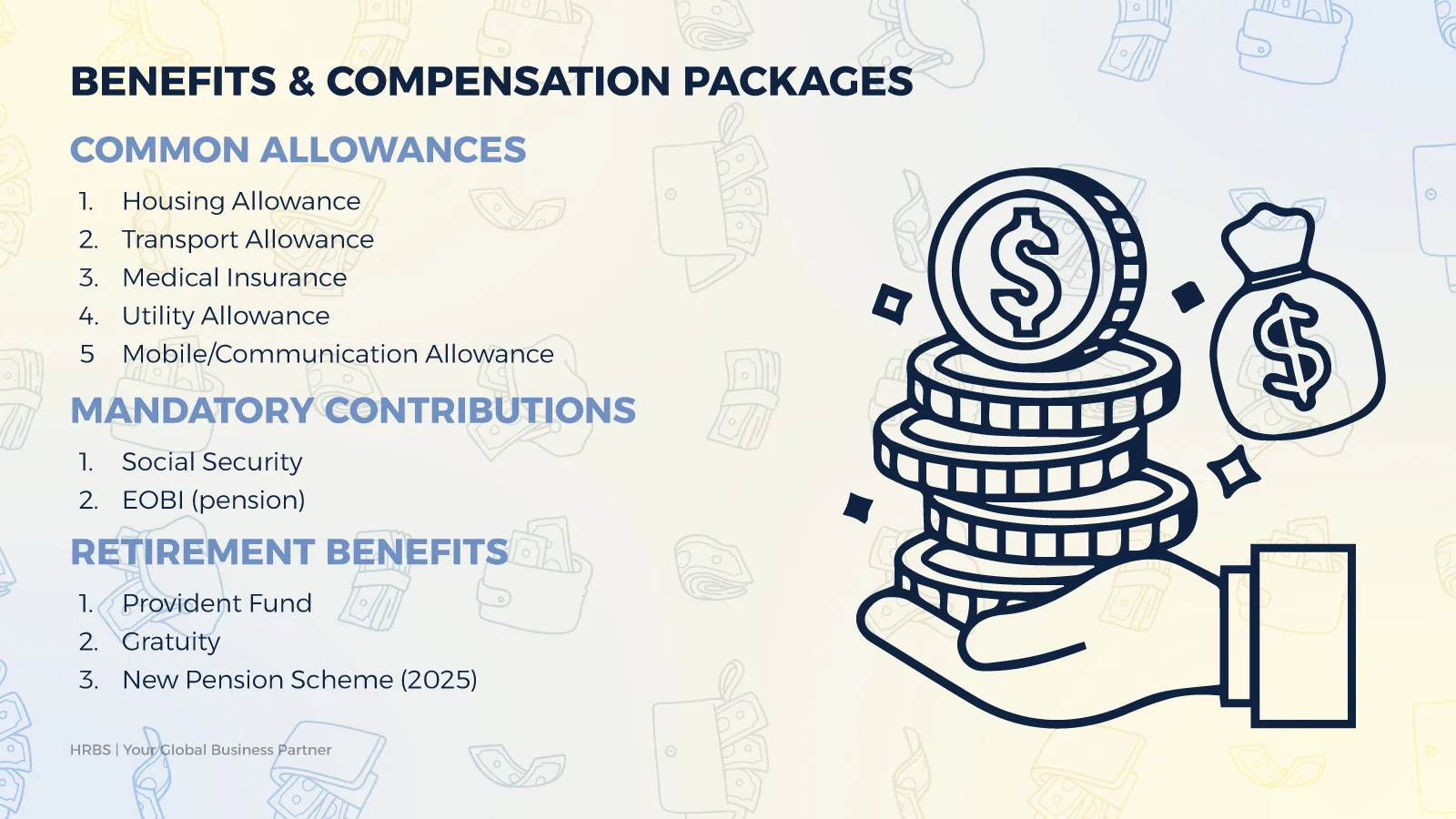Understanding salary benchmarks in Pakistan can make or break critical career decisions. Whether evaluating a job offer, planning a career switch, or researching the Pakistani labor market for hiring purposes, accurate compensation data shapes everything from negotiation strategies to relocation choices. The challenge? Salary information across Pakistan varies widely by industry, city, experience level, and gender, with women earning 30% less than men for similar work, a gap that significantly impacts market realities, labor law compliance, and career paths.
This complete guide breaks down the average salary in Pakistan across multiple areas. Inside, discover how compensation compares across major industries from healthcare to IT, what professionals earn in Karachi, Lahore and Islamabad, and how experience levels impact earning potential throughout career growth.
What is Average Salary in Pakistan?
Average salary in Pakistan refers to the mean earnings across workers in the country’s labor force during a specific timeframe. It’s calculated by adding up the total salaries of all employees and dividing by the number of workers. This calculation typically includes base pay plus regular monetary compensation such as allowances and fixed benefits that form part of standard pay packages. The resulting figure serves as a benchmark representing typical earnings across Pakistan’s workforce.
Employers use average salary data to set competitive compensation packages, while job seekers rely on these benchmarks to evaluate offers and negotiate fair pay based on their qualifications and experience level. Average salary data serves as the foundation for informed career decisions, effective salary negotiations, and strategic workforce planning across Pakistan’s diverse economic landscape.

Average Salary Overview in Pakistan (2025)
Average salaries in Pakistan vary significantly across professions, industries, and experience levels. Understanding the key salary metrics helps jobseekers evaluate offers and employers benchmark compensation effectively.
The Calculated Average
The mathematical average salary in Pakistan is PKR 82,100 per month (approximately USD 292-296), calculated by dividing total earnings by the number of workers. However, this figure is skewed by high earners and doesn’t reflect what most people actually make. The median salary of PKR 70,700 provides a more realistic benchmark for typical earnings.
Key Salary Figures
Minimum Wage:
- PKR 40,000 per month is the statutory minimum wage across major provinces including Punjab, Sindh, and Balochistan
- Translates to approximately PKR 1,423 per day
- Annual minimum wage: PKR 444,000
Median Salary:
- PKR 70,700 per month represents the median income
- Half of all workers earn more than this amount, while half earn less
- Provides a more realistic picture of typical earnings than mathematical averages
Salary Range:
- Lower end: PKR 20,700 per month (entry-level and unskilled positions)
- Upper end: PKR 365,000+ per month (senior management and specialized roles)
- High-demand sectors like healthcare and IT exceed these ranges significantly
Annual and Hourly Breakdown:
- Average annual earnings: PKR 985,200 (approximately USD 3,524)
- Average hourly wage: PKR 470 (approximately USD 1.68)
- Useful benchmarks for part-time, freelance, or contract workers
Salary by Industries Types in Pakistan
Salary levels in Pakistan vary across industries, with specialized sectors like information technology, healthcare, and finance offering significantly higher compensation than traditional fields. Understanding industry-specific pay scales helps jobseekers target high-growth sectors and employers benchmark competitive salaries effectively.
Highest-Paying Industries
Information Technology (IT): IT professionals earn some of Pakistan’s highest salaries, with software engineers averaging PKR 50,000-250,000 monthly. Specialized roles like IT Directors and IT Architects command premium compensation exceeding PKR 200,000. Remote work opportunities with international companies often push salaries significantly above national averages.
Key positions:
- Software Engineer: PKR 50,000-250,000 monthly
- IT Director: PKR 180,000-224,000 monthly
- IT Architect: PKR 180,000-214,000 monthly
- Cybersecurity Manager: PKR 50,000-150,000 monthly
Healthcare and Medical: Healthcare remains one of the most stable and well-compensated sectors in Pakistan. Physicians and surgeons earn PKR 61,000-462,000 monthly depending on specialization, with experienced specialists at the higher end. Dentists and medical data analysts also command strong salaries ranging from PKR 79,000-250,000.
Typical salary ranges:
- Physicians and Surgeons: PKR 61,000-462,000 monthly
- Dentists: PKR 87,000-250,000 monthly
- Healthcare Data Analyst: PKR 70,000-90,000 monthly
- Medical Specialists: PKR 150,000-300,000 monthly
Finance and Banking: Finance sector professionals, particularly Chartered Accountants, command some of Pakistan’s highest salaries ranging from PKR 100,000 to PKR 1,000,000 monthly based on seniority. Banking roles typically pay PKR 50,000-296,000, with management positions at the higher end.
Key roles:
- Chartered Accountant: PKR 100,000-1,000,000 monthly
- Finance Manager: PKR 150,000-200,000 monthly
- Bank Manager: PKR 103,000-296,000 monthly
- Finance Officer: PKR 40,000-60,000 monthly
Engineering: Traditional engineering disciplines offer varied compensation based on specialization. Petroleum engineers lead with monthly salaries of PKR 120,000-180,000, while electrical engineers earn PKR 80,000-150,000. Architectural and civil engineers also command strong salaries with opportunities domestically and internationally.
Industry breakdown:
- Petroleum Engineer: PKR 120,000-180,000 monthly
- Electrical Engineer: PKR 80,000-150,000 monthly
- Mechanical Engineer: PKR 75,000-140,000 monthly
- Civil Engineer: PKR 70,000-130,000 monthly
Mid-Range Industries
- Telecommunications: Professionals earn competitive salaries averaging PKR 60,000-100,000 monthly, driven by Pakistan’s expanding mobile and internet infrastructure. Network engineers and telecommunications specialists benefit from steady demand as connectivity continues growing nationwide.
- Digital Marketing: Digital marketing has emerged as a high-growth field with salaries ranging from PKR 50,000 to PKR 150,000 depending on experience. SEO specialists, social media managers, and content creators enjoy flexibility and strong earning potential, particularly when working with international clients.
- Construction and Manufacturing: Construction workers earn PKR 50,000-90,000 monthly on average, while manufacturing sector salaries range from PKR 50,000 to PKR 80,000 depending on role and industry subsector. Senior positions in construction management and manufacturing operations command higher compensation.
Lower-Paying Industries
- Agriculture and Food Industry: Agriculture sector salaries range from PKR 35,000 to PKR 75,000 monthly for general workers. Agricultural engineers earn higher compensation at PKR 60,000-80,000 monthly, but the sector overall offers lower pay compared to technology and healthcare.
- Retail and Services: Entry-level retail and service positions typically pay near minimum wage levels, ranging from PKR 37,000 to PKR 55,000 monthly. Career progression in retail management can increase earnings to PKR 80,000-120,000.

Average Salaries by Professions in Pakistan
Professional roles in Pakistan command vastly different compensation levels based on the education requirements, specialized skills needed, and experience demanded for each position.
| Professions | Average Monthly Salary | Salary Range |
| Chief Executive Officer | PKR 267,410 | PKR 200,000-400,000+ |
| Surgeon/Medical Specialist | PKR 250,000 | PKR 150,000-1,200,000 |
| IT Director | PKR 220,000 | PKR 180,000-300,000 |
| Chartered Accountant | PKR 200,000 | PKR 100,000-1,000,000 |
| IT Architect | PKR 190,000 | PKR 180,000-280,000 |
| Software Engineer | PKR 100,000 | PKR 50,000-250,000 |
| Finance Manager | PKR 150,000 | PKR 120,000-220,000 |
| Sales Director | PKR 170,000 | PKR 130,000-250,000 |
| Petroleum Engineer | PKR 110,000 | PKR 100,000-220,000 |
| Dentist | PKR 120,000 | PKR 87,000-250,000 |
| Bank Manager | PKR 150,000 | PKR 103,000-296,000 |
| Marketing Manager | PKR 110,000 | PKR 80,000-180,000 |
| Civil Engineer | PKR 100,000 | PKR 70,000-150,000 |
| Electrical Engineer | PKR 115,000 | PKR 80,000-160,000 |
| Graphics Designer | PKR 50,700 | PKR 35,000-90,000 |
| Healthcare Data Analyst | PKR 70,000 | PKR 60,000-110,000 |
| Administrative Assistant | PKR 40,000 | PKR 30,000-50,000 |
| Data Entry Operator | PKR 45,000 | PKR 30,000-60,000 |
| General Laborer | PKR 35,000 | PKR 35,000-55,000 |
| Agricultural Worker | PKR 37,000 | PKR 35,000-65,000 |
Average Monthly Salaries by Cities/Regions
Location significantly impacts salary levels in Pakistan, with major commercial hubs offering higher compensation to offset living costs and attract talent. Urban centers like Karachi and Lahore consistently pay more than smaller cities due to concentration of multinational companies and stronger economic activity.
| City | Average Monthly Salary | Annual Salary |
| Karachi | PKR 80,000 | PKR 1,064,400 |
| Lahore | PKR 75,000 | PKR 1,046,400 |
| Islamabad | PKR 76,700 | PKR 920,400 |
Karachi leads as Pakistan’s highest-paying city, followed closely by Lahore, reflecting their status as the country’s primary commercial and industrial centers. Islamabad, despite being the capital, offers slightly lower average salaries but provides better quality of life and government sector opportunities.
How Experience Affects Salary Growth?
Experience is one of the strongest predictors of salary growth in Pakistan, with compensation increasing steadily as professionals advance in their careers. The steepest salary gains occur during the first 10 years of employment, after which increases moderate.
| Experience Level | Salary Increase vs Previous Level | Cumulative Increase vs Entry-Level |
| Entry-Level (0-2 years) | Baseline | 0% |
| Junior (2-5 years) | +32% | +32% |
| Mid-Level (5-10 years) | +21% | +60% |
| Senior (10-15 years) | +14% | +82% |
| Expert (15-20 years) | +9% | +98% |
| Executive (20+ years) | +9% | +116% |
An entry-level professional earning PKR 50,000 monthly can expect to earn approximately PKR 66,000 after 2-5 years of experience, PKR 80,000 after 5-10 years, and over PKR 100,000 after 15+ years in the same field. The largest percentage jump occurs between entry-level and junior positions, making the first few years critical for career advancement.
Average Salary By Education Level
Educational qualifications have a direct correlation with earning potential in Pakistan, with each additional level of education translating to measurable salary increases. Higher education investments yield substantial long-term returns, with bachelor’s degree holders earning significantly more than those with only secondary education.
| Education Level | Average Increase Over Baseline | Typical Monthly Salary Range |
| Primary School | +27% | PKR 35,000-45,000 |
| Middle School | +40% | PKR 37,000-45,000 |
| High School/Matric | +50% | PKR 45,000-50,000 |
| Intermediate/College | +57% | PKR 55,000-60,000 |
| Bachelor’s Degree | +71% | PKR 65,000-110,000 |
| Master’s/Tertiary Education | +82% | PKR 80,000-150,000+ |
Bachelor’s degree holders earn approximately 71% more than workers with only primary education, while those with master’s degrees or professional certifications earn 82% more. Each year of additional schooling contributes roughly 7-8% to lifetime earnings, making education one of the most reliable paths to higher income in Pakistan’s labor market.
Public vs Private Sector Salary Comparison
The choice between public and private sector employment in Pakistan involves more than just salary comparisons, as each offers distinct compensation structures and benefits packages. While headline salary figures vary by position and experience level, understanding the complete compensation picture helps jobseekers make informed career decisions.
| Factor | Public Sector | Private Sector |
| Overall Wage Premium | +12% higher on average | Baseline |
| Clerical Staff | +34% higher | -34% lower |
| Skilled Workers | +25-30% higher | -25-30% lower |
| Professionals | +15-20% higher | -15-20% lower |
| Mid-Management | +10-15% higher | -10-15% lower |
| Senior Executives | -10-20% lower (wage penalty) | +10-20% higher |
| Female Workers (General) | +28-76% higher | -28-76% lower |
| Annual Pay Raises | 7.5-8% every 18-19 months | 8-13% every 18-19 months (varies by industry) |
| Entry Requirements | Competitive exams, structured hiring | Merit-based, flexible hiring |
How Industry Industry Growth Rates Affect Salaries?
Salary increment rates vary significantly by sector:
| Industry | Annual Average Increment |
| Information Technology | 6-13% |
| Healthcare | 8-12% |
| Banking & Finance | 5-8% |
| Education | 3-5% |
| Manufacturing | 4-6% |
IT and healthcare professionals consistently receive the most substantial salary increases, driven by strong demand and skills shortages. Banking sector growth has moderated compared to previous years, while education remains among the slowest-growing sectors.
Experience-Based Increment Patterns
Career stage significantly influences raise percentages:
- Junior professionals (0-5 years): 3-5% annually
- Mid-level professionals (5-10 years): 6-9% annually
- Senior professionals (10-15 years): 10-15% annually
- Top management (15+ years): 15-20% annually
Gender Pay Gap Analysis in Pakistan
Women in Pakistan’s workforce face a significant wage disparity compared to their male counterparts, earning substantially less despite often having equal or higher educational qualifications. The 2025 ILO Gender Pay Gap Report reveals that this inequality persists across all sectors and represents one of the highest disparities among lower-middle-income countries. Here is gender pay gap by categories:
| Category | Pay Gap Percentage | Context |
| Hourly Wages (Overall) | 25% less | Women earn 25% less per hour than men |
| Monthly Wages (Overall) | 30% less | Gap widens due to fewer paid hours worked |
| Informal Sector | 40%+ less | Highest disparity due to lack of oversight |
| Low Education Level | 40%+ less | Largest gap among workers with minimal education |
| High Education Level | 15-20% less | Education partially mitigates but doesn’t eliminate gap |
| Public Sector | 5-10% less | Smallest gap due to standardized pay scales |
| Private Sector (Formal) | 25-30% less | Moderate gap with some regulation |
| Agriculture & Manufacturing | 35%+ less | Higher than service sector disparities |
Beyond wage disparities, women face severe barriers to employment entry. Women’s employment rate stands at just 23% compared to 79% for men, creating a 56 percentage point employment gap, the largest in South Asia. Women represent only 13.5% of total wage employees, despite comprising nearly half of Pakistan’s working-age population.
Minimum Wage vs Living Wage Gap in Pakistan
The gap between minimum wage and living wage in Pakistan reveals a critical shortfall in worker compensation. While the government-mandated minimum wage establishes the legal baseline employers must pay, the living wage represents what workers actually need to afford necessities for themselves and their families.
Current Minimum Wage
As of 2025, Pakistan’s statutory minimum wage stands at PKR 40,000 per month across major provinces, though Punjab recently increased this to PKR 40,000 effective July 2025. This baseline applies to unskilled workers across sectors including manufacturing, construction, and agriculture.
The minimum wage translates to:
- Daily rate: PKR 1,423
- Annual income: PKR 444,000-480,000
- Hourly equivalent: Approximately PKR 178 (based on 8-hour workday)
Living Wage Estimates
The living wage, calculated based on actual costs for food, housing, healthcare, education, and transport, is estimated at PKR 51,706 per month for a family of three in Pakistan. This figure represents what workers need to maintain a decent standard of living with dignity.
Recent analysis by the Centre for Labour Research shows that even with the revised minimum wage of PKR 37,000-40,000, there remains a wage gap of PKR 19,700, translating to a 38% shortfall between what workers earn and what they need to live.
Public vs Private Sector Salary Comparison
The choice between public and private sector employment in Pakistan involves more than just salary comparisons, as each offers distinct compensation structures and benefits packages. While headline salary figures vary by position and experience level, understanding the complete compensation picture helps jobseekers make informed career decisions.
Benefits & Compensation Packages in Pakistan
Salary packages in Pakistan extend beyond base pay to include allowances and mandatory benefits that can add 30-50% to total compensation. Understanding these components helps accurately compare job offers and evaluate true earning potential.
Common Allowances
- Housing Allowance: Typically 45-50% of basic salary, this is the largest component after base pay and often tax-exempt up to certain limits.
- Transport Allowance: Ranges from PKR 5,000-20,000 monthly depending on position level, covering commuting costs or providing company vehicles for senior roles.
- Medical Insurance: Comprehensive health coverage for employees and immediate family members, with cashless hospitalization at network hospitals.
- Utility Allowance: Covers electricity, gas, and internet costs, particularly common for senior positions or remote work arrangements.
- Mobile/Communication Allowance: PKR 2,000-10,000 monthly for roles requiring regular business communication.
Mandatory Contributions
Employers must contribute to social security programs:
- Social Security: 5-6% of employee salary
- EOBI (pension): 5% of minimum wage
- Employees contribute 1% each to both schemes
Retirement Benefits
- Provident Fund: Both employer and employee contribute 8-10% of basic salary monthly to an interest-bearing account accessible upon retirement.
- Gratuity: Calculated as (Last year’s salary ÷ 26) × 30 × years of service, paid as lump sum upon retirement or resignation.
- New Pension Scheme (2025): Government employees hired after July 2024 contribute 10% of salary with 12% employer match, managed by pension fund managers.
What Total Compensation Looks Like?
A position offering PKR 80,000 base salary typically includes:
- Base Salary: PKR 80,000
- Housing Allowance (45%): PKR 36,000
- Transport: PKR 10,000
- Medical Insurance Value: PKR 5,000-8,000
Total monthly package: PKR 131,000-134,000
When evaluating job offers, calculate total compensation by adding base salary plus all allowances and employer contributions. A lower base salary with comprehensive benefits often provides greater value than a higher base salary with minimal perks.

How to Negotiate Salary in Pakistan
Effective salary negotiation in Pakistan begins with thorough market research and a clear understanding of industry benchmarks. Jobseekers should enter negotiations with data on typical pay for the position, factoring in their own skills, experience, and location.
Key steps include:
- Researching salary ranges for the specific role and sector.
- Clearly communicating skills, achievements, and relevant experience.
- Highlighting added value, such as specialized certifications or unique expertise.
- Considering total compensation (base, allowances, and benefits) rather than just basic salary.
- Remaining flexible and open to negotiation on components like bonuses, medical coverage, and professional development.
Polite yet confident communication, backed by current salary trends and personal accomplishments, increases the likelihood of a favorable outcome in Pakistani salary discussions.
Conclusion
Understanding salary dynamics in Pakistan requires looking beyond simple averages to consider the multiple factors that shape earning potential across the country’s diverse labor market. Industry selection, geographic location, educational qualifications, and years of experience all play critical roles in determining compensation levels, while persistent gender disparities continue to impact women’s earnings across all sectors.
Pakistan’s skilled workforce, growing economy, and expanding opportunities in technology, healthcare, and finance create a dynamic environment for both employers and job seekers. Organizations that understand market-competitive compensation structures can attract and retain top talent, while professionals equipped with comprehensive salary insights can make informed career decisions that align with their financial goals and lifestyle needs.
FAQs
What is a good salary in Pakistan?
A good salary in Pakistan depends on location, lifestyle, and family size. In major cities, PKR 100,000-150,000 monthly allows comfortable living with savings potential for a family of four. Single professionals can live comfortably on PKR 60,000-80,000 in urban areas, while PKR 200,000+ enables upper-middle-class lifestyle with private education and home ownership potential.
How much do fresh graduates earn in Pakistan?
Fresh graduates typically earn PKR 30,000-60,000 monthly depending on field and employer. Engineering graduates start at PKR 40,000-70,000, business graduates at PKR 35,000-55,000, and IT graduates at PKR 45,000-80,000. Multinational companies and tech startups offer higher starting salaries (PKR 60,000-100,000) compared to local SMEs.
Which city pays the highest salary in Pakistan?
Karachi offers the highest average salaries at PKR 88,700 monthly, followed closely by Lahore (PKR 87,200) and Faisalabad (PKR 85,700). Islamabad ranks fourth at PKR 76,700 despite being the capital, though it offers better quality of life and lower living costs than Karachi.
What is the highest paying job in Pakistan?
Chief Executive Officers earn the highest salaries, averaging PKR 267,410 monthly with top earners exceeding PKR 400,000. Medical specialists and surgeons earn PKR 150,000-1,200,000 monthly depending on specialization. Chartered Accountants can earn PKR 100,000-1,000,000 monthly based on experience and firm size.
How can I increase my salary in Pakistan?
Increase salary through education (master’s degrees add 82% to earnings), skill certifications (project management, cloud computing, data analysis), switching industries to higher-paying sectors (IT, healthcare, finance), negotiating raises every 18-24 months, and pursuing management positions which offer 60-100% salary premiums over individual contributor roles.
What is upper-middle-class salary in Pakistan?
Upper-middle-class households in Pakistan typically earn PKR 200,000-400,000 monthly. This income level enables homeownership, private school education for children, car ownership, international travel, comprehensive healthcare, and significant savings. It represents the top 10-15% of wage earners in the country.
Do men and women earn equal salaries in Pakistan?
No, women in Pakistan earn 25-30% less than men for comparable work. The gender pay gap is largest in informal sectors (40%+) and smallest in public sector (5-10%). Women with higher education still face 15-20% wage disadvantages, while those with low education experience 40%+ gaps.
What benefits should I expect in a Pakistan salary package?
Standard benefits include housing allowance (45-50% of basic salary), transport allowance (PKR 5,000-20,000), medical insurance for family, provident fund contributions (8-10% employer match), gratuity upon retirement, and social security contributions. Total compensation packages typically add 30-50% to base salary through these benefits.
How often do salaries increase in Pakistan?
Pakistani employees receive salary increases every 18-19 months on average. Public sector workers get 7.5-8% raises based on standardized scales, while private sector increases range from 8-13% depending on performance and industry. High-growth sectors like IT see annual increases of 15-20%.



